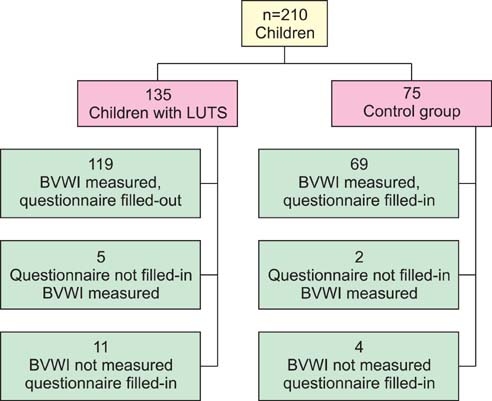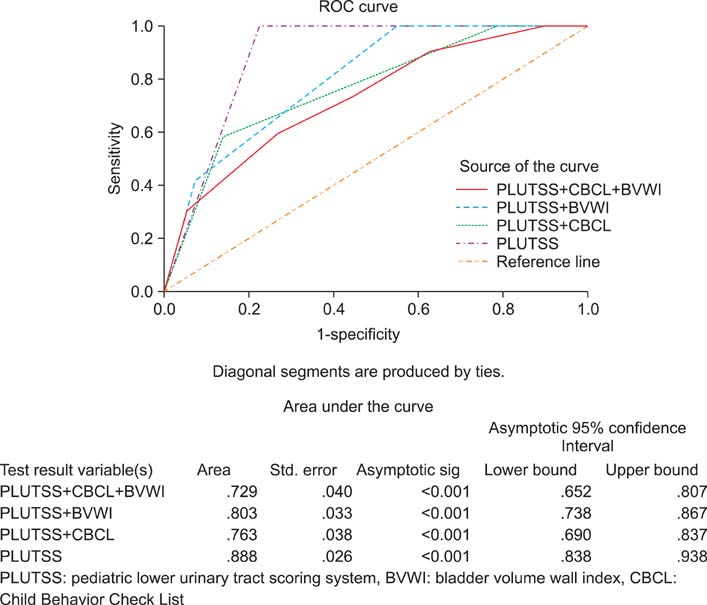Korean J Urol.
2011 Mar;52(3):210-215.
Correlation between Lower Urinary Tract Scoring System, Behavior Check List, and Bladder Sonography in Children with Lower Urinary Tract Symptoms
- Affiliations
-
- 1Department of Pediatric Nephrology, Ali-Asghar Children Hospital, Tehran University of Medical Sciences, Tehran, Iran. nhooman@tums.ac.ir
- 2Department of Radiology, Ali-Asghar Children Hospital, Tehran University of Medical Sciences, Tehran, Iran.
- 3Iranian National Center of Addiction Studies, Tehran University of Medical Sciences, Tehran, Iran.
- 4Department of Community Medicine, Tehran University of Medical Sciences, Tehran, Iran.
Abstract
- PURPOSE
The Pediatric Lower Urinary Tract Scoring System (PLUTSS) is a standardized questionnaire used for screening and evaluation of the response of children with lower urinary tract symptoms (LUTS) to therapy. We presumed that adding the Child Behavior Check List (CBCL) and bladder volume wall index (BVWI) to the PLUTSS would increase its validity in the detection of children with LUTS.
MATERIALS AND METHODS
One hundred twenty-two children aged 5 to 15 years with LUTS were enrolled in the study. Seventy-two healthy, age-matched children without urinary complaints were considered as controls. The PLUTSS and CBCL were filled out for all children. Sonography was performed to measure BVWI. Chi-square test and likelihood ratio were used to compare frequencies, receiver operating curve (ROC) analysis was used to evaluate the correlation, and Cohen's kappa was used to measure the agreement between variables. p-values <0.05 were considered significant.
RESULTS
Behavior problems were significantly more common in children with LUTS than in healthy children (p<0.05). The frequency of thick, thin, and normal BVWIs did not differ significantly in the two groups (p>0.05). ROC analysis showed that there was no correlation between PLUTSS, CBCL, and BVWI in either the LUTS subgroup or in the controls (p>0.05). The PLUTSS had the highest sensitivity and specificity, and adding the two other tests decreased its validity for the diagnosis of children with LUTS.
CONCLUSIONS
The PLUTSS by itself was the best predictor of LUTS. The CBCL and BVWI were not helpful in making a diagnosis; however, the CBCL was useful in the detection of behavior problems in children with non-monosymptomatic enuresis.
Keyword
MeSH Terms
Figure
Reference
-
1. Minassian VA, Lovatsis D, Pascali D, Alarab M, Drutz HP. Effect of childhood dysfunctional voiding on urinary incontinence in adult women. Obstet Gynecol. 2006. 107:1247–1251.2. Farhat W, Bägli DJ, Capolicchio G, O'Reilly S, Merguerian PA, Khoury A, et al. The dysfunctional voiding scoring system: quantitative standardization of dysfunctional voiding symptoms in children. J Urol. 2000. 164:1011–1015.3. Wallis MC, Khoury AE. Symptom score for lower urinary tract dysfunction in pediatric urology. Curr Urol Rep. 2006. 7:136–142.4. Bartkowski DP, Doubrava RG. Ability of a normal dysfunctional voiding symptom score to predict uroflowmetry and external urinary sphincter electromyography patterns in children. J Urol. 2004. 172:1980–1985.5. Achenbach TM. Manual for the child behavior checklist/4-18 and 1991 profile. 1991. Burlington: University of Vermont.6. Joinson C, Heron J, Butler U, von Gontard A. Psychological differences between children with and without soiling problems. Pediatrics. 2006. 117:1575–1584.7. von Gontard A, Mauer-Mucke K, Plück J, Berner W, Lehmkuhl G. Clinical behavioral problems in day- and night-wetting children. Pediatr Nephrol. 1999. 13:662–667.8. Yeung CK, Chiu HN, Sit FK. Bladder dysfunction in children with refractory monosymptomatic primary nocturnal enuresis. J Urol. 1999. 162:1049–1054.9. Zink S, Freitag CM, von Gontard A. Behavioral comorbidity differs in subtypes of enuresis and urinary incontinence. J Urol. 2008. 179:295–298.10. Mori R, Lakhanpaul M, Verrier-Jones K. Diagnosis and management of urinary tract infection in children: summary of NICE guidance. BMJ. 2007. 335:395–397.11. Nevéus T, von Gontard A, Hoebeke P, Hjälmås K, Bauer S, Bower W, et al. The standardization of terminology of lower urinary tract function in children and adolescents: report from the Standardisation Committee of the International Children's Continence Society. J Urol. 2006. 176:314–324.12. Leung VY, Chu WC, Yeung CK, Sreedhar B, Liu JX, Wong EM, et al. Nomograms of total renal volume, urinary bladder volume and bladder wall thickness index in 3,376 children with a normal urinary tract. Pediatr Radiol. 2007. 37:181–188.13. Yeung CK, Sreedhar B, Leung YF, Sit KY. Correlation between ultrasonographic bladder measurements and urodynamic findings in children with recurrent urinary tract infection. BJU Int. 2007. 99:651–655.14. Yeung CK, Sreedhar B, Leung VT, Metreweli C. Ultrasound bladder measurements in patients with primary nocturnal enuresis: a urodynamic and treatment outcome correlation. J Urol. 2004. 171:2589–2594.15. Schast AP, Zderic SA, Richter M, Berry A, Carr MC. Quantifying demographic, urological and behavioral characteristics of children with lower urinary tract symptoms. J Pediatr Urol. 2008. 4:127–133.16. Bael A, Winkler P, Lax H, Hirche H, Gäbel E, Vijverberg M, et al. Behavior profiles in children with functional urinary incontinence before and after incontinence treatment. Pediatrics. 2008. 121:e1196–e1200.
- Full Text Links
- Actions
-
Cited
- CITED
-
- Close
- Share
- Similar articles
-
- Pathophysiology of lower urinary tract dysfunction in the older patient
- Clinical implications of underactive bladder
- The Urinary Tract Microbiome in Male Genitourinary Diseases: Focusing on Benign Prostate Hyperplasia and Lower Urinary Tract Symptoms
- The Urobiome and Its Role in Overactive Bladder
- Current Trend of the Primary Treatment in Lower Urinary Tract Symptom/Benign Prostatic Hyperplasia



